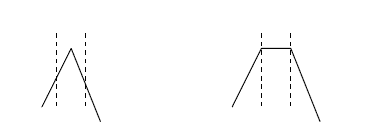

Together with H*H, pitch accent H*L is a very striking pitch accent to non-native listeners because of its very high pitch. It is a steep rise coming from low or mid pitch to high pitch. The high ending is reached at the beginning of the accented syllable. At the end of the accented syllable, the pitch drops to low and continues low or slightly falling to the end of the utterance. In the examples, H*L occurs in words in a number of different positions of the utterance.
The main communicative function of this accent is a yes/no question (without question word). Other communicative functions are: a continuation, a contrast, prominence (strong emphasis) in narratives and statements. It may also express a repeated question, a repeated wh-question and an alternative question.
H*L examples 6-12 and 18 have been taken from spontaneous speech, examples 1-5 and 13-17 from prepared speech.
1. This utterance is an example of accent H*L expressing a yes/no question.

2. Here is another example of a yes/no question.

3. The following example is also a yes/no question. Note that the pitch accent is realized in the final syllable of the utterance. No syllables follow the highest point reached in the final accented syllable, so the low post-tonic part of the accent remains unrealized and is thus truncated (“cut off”).

4. Here is another example of a yes/no question.

5. This is another example of a yes/no question.

6. The next example is a reduced realization of accent H*L expressing a yes/no question.

7. Here is an example of accent H*L expressing incompleteness.

8. In the following example the pitch accent expresses incompleteness.

9. In the next example the pitch accent also expresses incompleteness. Note that this example can also be interpreted as a yes/no question.

10. In this example the pitch accent expresses a strong contrast in an incomplete utterance.

11. In this example the pitch accent expresses a contrast in an incomplete utterance which requires a right context, that is, a continuation.

12. The following utterance is an example of a repeated question. Note that the particle “li” already signals a question.

13. In the first utterance there is an example of pitch accent H*L expressing a repeated question without question word, after the boundary followed by an utterance with two pitch accents: H*M and HL*. The speaker is surprised that her interlocutor talked about apples.

14. The next example presents a repeated question with question word and is a reaction to the question ‘I wonder, why didn’t he answer the letter?’. Accent H*L is realized in the verb ‘answer’.

15. Here is another example of a repeated question with question word in the first utterance where accent H*L is realized in the verb ‘arrive’. Note that in the second utterance accent HL* is a single harmonica pattern which explains the rising pitch movement after falling accent HL*. The example answers the question ‘when will you arrive?’

16. The next example is an example of an alternative question in the first utterance, after the boundary followed by an utterance with pitch accent HL*.

17. In this utterance the slightly reduced realization of the pitch accent in the first utterance expresses an alternative question, after the boundary followed by an utterance with pitch accent HL*.

18. The next utterance is an example of the pitch accent expressing strong emphasis.
